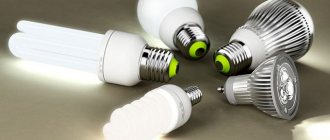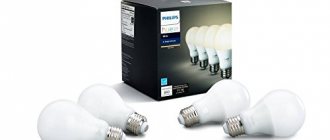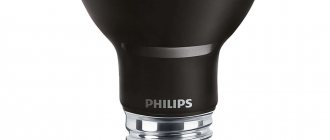A pressing problem when using LED lighting equipment as the main lighting is the periodic pulsation of the light flux. Why does the LED ceiling light blink when turned on? This is due to the characteristics of the LED matrix, which passes direct electric current exclusively in one direction, unlike incandescent lamps.
From an ordinary incandescent light bulb, the light also pulsates, but in this case the electrons can move in different directions, accordingly, the flickering frequency is similar to the frequency of an alternating electric current (50 Hz). Therefore, the organs of vision do not perceive such flickering. The amplitude of the light pulsation is also minimal due to the heating of the spiral. The light flow from such a light source has only one direction; accordingly, due to changes in the mains voltage, the brightness of the lighting also changes.
Operating principle and device
LED lamps have a more complex structure compared to incandescent or halogen lamps. The design includes the following parts:
- Diffuser in the form of a hemisphere. Made from plastic or glass.
- LED matrix.
- Aluminum board for heat dissipation.
- Radiator.
- Driver. It is because of a low-quality driver that the light bulb blinks most often.
- The base of the plinth is made of polymer.
- Base.
Depending on the type of light bulb, the design may vary.
In classical light sources, voltage was applied directly to the spiral, which acted as active resistance. LED contains special converters - drivers. When power is applied, current flows through the base to the converter and then to the LED matrix itself. The converter changes the current and voltage to optimal values for operation.
The following main causes of lamp flickering can be identified:
- Constant power surges.
- Low voltage in the network.
- Malfunction of components in the circuit.
The breakdown must be found and repaired as quickly as possible.
The main reasons why an LED lamp or lamp blinks when the light is on
There are only a few options for this problem:
- Low voltage in the network;
- Faulty starting equipment;
- Power surges.
Low voltage in the network
In order to identify this problem, you need to check the voltage level in the network.
To do this you need a regular multimeter or voltmeter.
At a normal voltage level, the indicator should read from 215 to 225 V. These are permissible errors in a stationary electrical network.
If this indicator is below 200 V or above 250 V, you will need to contact the housing office or energy supply organization so that they carry out all the necessary measurements and, in cases of discrepancy, adjust the operation of the power transformer at the substation.
Often in practice, specialists from the power supply organization will not be able (or will not want) to adjust the voltage level in accordance with the PUE, in which case you will not be able to do without installing a voltage limiter or stabilizer.
Faulty starting equipment
This problem most often occurs with old LED lamps. It can be caused either by drying out of the electrolytic capacitor or by partial failure of the rectifier bridge.
In such cases, it is necessary to either repair the starting equipment (change the electrolyte) or buy a new LED lamp.
Power surges
Quite often, in houses or apartments with old wiring, short-term power surges occur, during which the voltage level can reach 280–320 V. In such cases, to protect all household electrical appliances and LED lighting, it is necessary to install voltage stabilizers that smooth out voltage drops and surges to the nominal value (220 V).
Reasons why cheap lamps flicker
Cheap products from little-known manufacturers often do not meet the declared characteristics. The reduction in the cost of goods is associated with the use of low-quality materials and savings on electronic components. This can be observed in cheap LED light bulbs, which begin to flicker almost immediately after purchase. The manufacturer installs cheap drivers, does not use radiators, and this affects the operation of the device.
The lamp blinks frequently, but in most cases the device remains operational. If the cause of the blinking is eliminated, the light bulb can be used for the time stated by the manufacturer without harm to health.
In cheap devices it is not always possible to fix the problem. For this reason, it is recommended to immediately buy a proven device from a reliable supplier. At the purchase stage, it will cost more, but all declared characteristics will correspond to the operating parameters.
The influence of switching power supplies on the quality of LED lighting
Every modern household appliance has a UPS. The principle of operation is that it is converted into a high-frequency signal of 50 hertz of household voltage, then it is rectified and processed. The technology unit contains built-in capacitors and chokes that filter out this high frequency. However, they can be damaged or not cope with this task in certain situations.
In such cases, a high-frequency signal from a microwave oven, TV or other household appliance will penetrate into the household network. As a result, high frequency interference will occur. They also affect the operation of the LED lamp driver. This is especially noticeable in devices that use a resistive-capacitive voltage divider or a simple transformer conversion. To check whether there is interference from high-frequency pulses from equipment in the apartment, you need to turn it off. If these noises come from neighbors or from the network, this method is not suitable. In such cases, it is more advisable to evaluate the quality of the supply voltage sinusoid with an oscilloscope. However, such verification is expensive.
Lamp flickering due to poor quality power supply
Not only cheap light bulbs are susceptible to ripples. Devices from the mid-price segment may also contain a cheaper power supply in their design, which will result in flickering when starting up.
The power supply consists of the following elements:
- Diode bridge with capacitive filter.
- Quenching capacitor.
An alternating current is supplied, which passes through the diode bridge. As it passes through, it is converted into direct current of the required magnitude, but with high ripple. Capacitive filter and damping capacitor reduce flicker. Current with equalized characteristics enters the lighting device, due to which the lamp operates in normal mode. If low-quality components are used, the circuit will not be able to achieve the desired characteristics, which will cause flickering.
Flashing can be detected either on one light bulb or on an entire group. The reasons for this phenomenon are the same, and they must be eliminated so that the working life of the devices is not reduced. The malfunction may occur in the off and on state.
Low frequency flickering of LED lamps
The amplitude of the alternating mains voltage changes with a frequency of 50 times/sec and has the form of a sinusoid. The luminescence of the matrix is provided exclusively by positive and negative half-waves passing through the LED. If a light source equipped with LEDs blinks, this may be the reason for significant savings on the power supply by the manufacturer.
In inexpensive models of such lighting equipment, a single-bridge rectifier is often used to reduce its cost, designed to convert AC voltage to DC. A certain number of oscillations are cut off after the diode bridge, and by adding a capacitor to the electrical circuit, ripple is reduced. Such a scheme allows you to observe the pulsation of the light flux with a frequency of 25 times/sec.
Important! If the LED light continues to blink even after adding a normal bridge rectifier to the circuit, then the problem is most likely in the capacitor.
The capacitor, as a rule, accumulates charge at the amplitude maximum and returns it to the load at the minimum. At the output, the average voltage amplitude decreases, and the ripple becomes significantly less. If the resource capacity is insufficient, the capacitor is not enough to recharge the LED elements, whose brightness changes with each half-wave. According to sanitary standards, the pulsation of the light flux should not be more than 10 percent of the nominal intensity.
Flashing when off
Ripple when the switch is inactive can be detected due to electric current entering the smoothing capacitor. There is an accumulation of current in it, which, when filled, enters the circuits and tries to activate the LED lamp. This supply is not enough for full operation, so the lamp will light up for a short period of time. The flashing will continue until the problem is resolved or the light bulb breaks.
The following components can affect the blinking of lamps:
- switch illumination;
- induced voltage;
- leakage currents.
You need to know these reasons in order to be able to quickly eliminate them.
Effect of switch illumination
Many manufacturers equip their switches with backlighting. It increases the comfort of use, as the switch starts to light up and becomes easier to find in the dark.
But additional lighting can cause flickering, especially with cheap light bulbs. This is due to parallel connection. When turned off, the current goes to power the backlight, and when turned on, it goes to the lamp.
This reason is one of the most common, so it is the switch illumination that you need to pay attention to when the lamp flickers.
Induced voltage
It occurs when several devices are connected to one multi-core cable. It can also be observed when laying several independent lines in one groove.
You can fix the problem by replacing one LED bulb with a device of lower power. You can temporarily install an incandescent lamp, but you must remember that it will also be affected by the induced voltage. The optimal solution would be to change the electrical wiring section and allocate a separate line for the lighting group.
Leakage currents
Leakage current is the most dangerous reason why a light bulb blinks. It appears due to poor quality and incorrect installation, damage to insulation, and poor contact. As a result, a circuit break occurs, which can lead to a fire. Even in a non-operating state, currents will flow to electrical appliances.
What can cause an energy-saving lamp to blink?
Problems and blinking of energy-saving lamps even when turned off can be caused by:
- Using switches with an illuminated indicator. A useful thing, especially if you have trouble seeing and orienting yourself in the dark. But there may be too much light.
- Wiring problems.
- Lamp non-compliance with quality standards.
You can fight each cause on your own, but it is better to take all precautions so as not to lose your health, and maybe even your life. Electricity is no joke
It’s unpleasant when at night, instead of going to bed after a busy day, you have to try to understand why the energy-saving lamp is blinking when the lights are off. It’s good that the problem can be solved by screwing in an ordinary lamp in parallel
. Well, or in a more radical way, by removing all energy-saving devices.
Video about blinking energy-saving lamps
In this video, electrician Ivan Matveev will talk about the reasons that cause the light to flicker when the light is turned off, and also describe how this phenomenon can be eliminated using a resistor and how to connect it:
Many people notice that LED lamps, especially inexpensive and budget Chinese models, can flicker and blink after the power is turned off, and sometimes even during operation. But there is no need to rush to pass a “sentence” on such a light source; perhaps the problem does not lie there at all and this malfunction can be easily eliminated. Let's try to figure it out...
Causes of flicker
Ripple when LED lamps are turned off or on can occur for the following reasons.
1.Problem with backlit switches
Typically, modern glow-in-the-dark switches have LED or neon lighting installed, which simply does not completely disconnect the network. That is, the main lighting turns off, and the backlight leaves the circuit “closed”, with a small current flowing through the switch. This becomes a charge for the capacitor, that is, it charges a little and the internal circuit of the lamp turns on, it glows, then the capacitor discharges and the lamp goes out. This process occurs cyclically.
2. Low quality of the lamps themselves
The source of pulsations can be low-quality lamps, namely, non-compliance with GOST requirements for the power of the power source. This is typical for lighting devices made in China.
3. Incorrect wiring
This usually happens in houses with old electrical wiring. The switch does not break the phase wire, as it should be, but the neutral wire. As a result, the circuit is under voltage, which creates flickering.
How to eliminate flicker?
Of course, the first priority action when such a phenomenon occurs is to replace the lamps. That is, if you still have the purchase receipt, you need to go to the store to replace the lamps or get a refund.
If the receipt has not been saved or there is no desire to deal with the return of the goods, you can upgrade or replace the switch. Replacement means purchasing a new switching device without backlight.
Upgrading the switch is more difficult. To do this, it is recommended to remove the LED from it, connect an additional load to the circuit parallel to the lamp in the form of a resistor with a resistance of 50 kOhm and a power of 2 W, or lay a separate electrical wire to the lamp. Of course, in order to perform these manipulations you must have some knowledge, skills and comply with safety requirements.
In conclusion...
Good advice in this case would be to purchase lamps from trusted manufacturers with a good reputation, so that you don’t have to change or redo anything later.
You can read more about LED lamps in this article.
Watch the video on how to get rid of flickering LED lamps:
Remedies
If the lights blink due to the backlight on the switch, you need to break the circuit. There are 6 main ways to fix the problem:
- shunting with a resistor;
- bypassing with a capacitor;
- connecting the backlight with a separate wire;
- use of a pass-through switch;
- dismantling the backlight inside the switch;
- turning on a conventional LED light bulb in parallel.
Turning off the switch backlight is the easiest way. To begin with, the switch is dismantled and the wires for the backlight are disconnected. You can also replace the old switch with a new one. It is recommended to take a device with neon lighting - it flickers less frequently than LED lighting.
Connection diagram for switch illumination through a resistor
When a group of light sources blinks, you can replace them with one incandescent lamp with low power. The flickering should disappear, but you need to take into account that the aesthetic properties of the chandelier will be impaired.
The problem can be fixed by installing a low-power 50 kOhm resistor for a power of 2 W. The work must be carried out efficiently, otherwise there is a risk of fire. All contacts must be reliably insulated.
Blinking may occur due to insulation problems. Violation of its integrity leads not only to unstable operation of the lamp, but also to a danger to human health.
Leakage currents can only be eliminated by repairing problem areas of the circuit. Sometimes it may be necessary to replace all electrical wiring in an apartment or house.
List of probable causes
Let's figure out why the chandelier blinks and how to get rid of it
Illuminated switch
The most common problem is flickering in the off position due to the backlit switch. This switch has a small LED that turns on when the key is in the off state. Just when the light is turned off, the circuit is interrupted and the lamp stops receiving electricity. But the backlight is connected together with the switch and when the circuit is interrupted, electricity flows to the LED.
It is precisely this small voltage necessary for the backlight to operate that is supported by the capacitor. As a result, the lamp goes out when it tries to turn on, because the small charge on the capacitor is not enough to operate effectively. Depending on how quickly the capacitor charges, the light bulb will constantly try to turn on. And you will notice how she blinks in the chandelier while working.
Disconnect the LED wires from the main circuit
It is important not to disconnect the desired wire and not to disconnect the phase or neutral. You can remove the indicator light and install a simple switch. It is necessary to connect an ordinary light bulb to the circuit; it will take over this part of the voltage from which the capacitor is charged. This is a bad option, since it’s unlikely to be possible to install an additional light bulb in a chandelier unnoticed.
And it will look ugly. On the Internet in various forums they write that just such a method for combating flicker helps to get rid of it. Connect the part that will consume electricity, which causes the blinking in the chandelier - this is a small resistor with a power of 2 W, resistance - 50 kOhm. The resistor is connected in the distribution box or near the cartridge. The connection must be made using a terminal block, and the resistor is insulated with a heat-shrinkable tube. Another method to get rid of the problem is to connect the backlight with a separate wire. This way, less electricity will be wasted, and it will burn all the time. The only disadvantage of this connection is the additional connection of wires.
It is best to use the first and fourth methods to fix the problem. If you want to have a backlight, purchase a resistor or simply cut the wires, so the energy-saving light bulb will not blink in the off position.
There were difficulties with the electrical wiring
Why, when you purchase a special LED lamp that does not blink when turned off, but the problem remains the same, then something is wrong with the electrical wiring. If the wiring is old, then the current may leak due to broken insulation or poor-quality twisting of the wires, hence the constant blinking of the LED lamp.
- To check the quality of the wiring connection, you need to disassemble the switch and the lamp; the problem may be poor contact.
- Check to see if the electrical wiring has been done properly; it happens that electricians connect to a break instead of a phase wire, a neutral wire. Most likely, the energy-saving light bulb will blink when turned on and off, but this is also very dangerous.
Rare exceptions
Sometimes there are circumstances when everything is working well and the wiring and switch are working properly, but the flashing and crackling still continues. Let's figure out why this happens. Such problems arise due to the following reasons:
- Defective product. If you purchased Chinese-made products, the manufacturer may have produced a defective product. Usually this rarely occurs, but as practice shows, such cases sometimes occur.
- Has developed its resource. If you have been using your energy-saving light bulb for many years, most likely some part on the chip has deteriorated, which is why it sometimes begins to flicker or does not turn on. Despite the fact that manufacturers guarantee that modern LED and fluorescent lamps last more than ten years, no one is held responsible for improper use. There is a possibility that you have constant voltage drops in the network or the light bulb is installed in a room with a low or high temperature. A variety of problems, even the most minor ones, can adversely affect the performance of an energy-saving light bulb.
- The starter has gone bad. The device responsible for turning on the fluorescent light bulbs is called a starter. It happens that the starter stops working and flashes when turned on. The starter can be replaced without problems, even by an electrician, without experience. The cost of such a part is inexpensive.
Blinking light when the switch is on
If the switch is in the active state, two reasons for the blinking can be distinguished:
- Low tension. Any light source is sensitive to low voltage. If a high-quality driver is installed in the LED bulb, stable operation can be achieved at 180 V. Lamps without a high-quality driver turn off already at 200 V. Flickering at voltages below 220 V will be observed at different frequencies and will stop when normal operating values are reached.
- Poor quality power supply. If the mains voltage is normal, the problem may be related to the power supply. The use of low-quality elements will not allow the device to equalize the current and bring the values to the optimal level.
The malfunction also appears when dimming a light bulb that is not designed for this function. Then the user will observe flickering when the brightness is lowered. Stable operation without pulsation will be noted if you turn on the lamp immediately to maximum brightness. The unsuitable lamp must be removed and a special dimmable light source installed.
There are two ways to identify the cause of flickering when it is turned on:
- Using a pencil. In a completely dark room, only the lamp being tested should be turned on. You need to quickly draw a pencil in front of it. If there is a continuous trail behind it, there is no flicker. If the trace is intermittent, pulsations are present.
- Test with a camera on a smartphone. You need to turn on the light bulb and point the camera at it at a distance of about a meter. When flickering occurs, dark streaks will appear on the screen. If there is no blinking, the image will be uniform and of the same color.
The LED lamp flashes after switching on:
- In case of voltage surges, a stabilizer is installed. It brings the current to the required parameters and at the same time prevents premature breakdowns of electrical appliances.
- The power supply can be upgraded independently. To do this, you should select a high-quality smoothing capacitor and place it in the circuit.
Users with electrical engineering skills will be able to make a reliable driver themselves.
Flickering of the switched on lamp
It's easy to find out why your LED spotlight is blinking. Just turn it on and look at the LED. To protect your eyes from bright flashes, you need to use dark glass:
- All crystals are connected in series with gold wires and glow blue.
- In operating condition, they heat up and transfer heat to the metal plate.
- If one of the crystals goes out, the contact between the wires is broken and the circuit stops working.
There are two reasons why an LED lamp may flicker when turned on. This is insufficient voltage in the network and a low-quality power supply. Sometimes the junction between the crystal and the wire shorts temporarily. The spotlight begins to blink periodically or constantly, then recovers. It is difficult to determine such a malfunction.
The LED element has two types of flicker: low frequency and high frequency. The mains current range changes at a frequency of up to 50 times per second. It is called sinusoidal. If the power supply is low, the LED lamps blink when turned on. This problem is most often observed in villages and some regional areas. The electricity supply is weak, and the voltage in the outlet does not exceed 200 V. What to do:
- In order for an LED light bulb to work stably and without interruptions, it must be equipped with a high-quality driver. For residents of such areas, lamp models with a voltage of 180-250 V are suitable.
- Sometimes low voltage appears if the device is turned on using a dimmer. If you do not turn it on completely, models that do not support dimmer will begin to flicker. To fix the problem, you need to increase the power. To do this, the adjusting knob is raised to the rated voltage.
- Any electrical appliance will work poorly and quickly fail with unstable voltage in the network. An installed resistor with a power of several kW will ensure stable voltage in the network.
- If the 12V lights that are connected to the power supply are blinking, this may be due to a lack of power. Most often, this problem occurs in spotlights when LED bulbs are installed instead of halogen models. There is a parallel connection here, which results in an additional load and a voltage drop.
If the LED is equipped with a bad power supply, then it will not be able to sufficiently smooth out the rectified voltage in the network. When the pulsation of light occurs with a small amplitude, it may not be noticeable to a person. But too much flicker, which occurs every day, affects the retina of the eyes, causing them great harm. A device with a pulsation of more than 20% affects mental activity and ability to work. You cannot read or work on a computer with this lighting:
- In Russia there are acceptable CP standards, which are regulated by SanPin 2.2.1/2.1.1.1278-03. Therefore, product manufacturers indicate the pulsation coefficient on each package. But products from Chinese manufacturers have inaccurate data. Most often, the CP indicated on the packaging exceeds the figure several times.
- If you purchased a product from an unknown manufacturer, you can try to change the technical characteristics of the device yourself. To ensure that the light bulb works without flickering, the smoothing capacitor is replaced. The base of the device is opened, the capacitor located inside is replaced with a similar model of higher capacity.
You can fix all problems with LED lamps yourself. The main thing is to establish the cause of the blinking and determine what method is best to get rid of the problem.
If the lamp blinks even during continuous operation, then a possible cause may be large (more than 5%) deviations in voltage. In this case, it is worth checking and eliminating these faults by calling specialists. After all, such deviations in the power supply of your home negatively affect not only the operation of LED light bulbs, but also all electrical equipment.
There are several reasons why a switched on LED lamp blinks. First of all, this includes poor-quality installation. If the circuit contacts are not connected securely enough, this leads to various unfavorable phenomena. One of them is the flickering of the LED device.
When connecting wires, the correct polarity must be observed. If the conductors are color coded, the connection is easier. But in old houses you have to use a special device. It will help you figure out where the “phase” and “zero” wires are located. Otherwise, a small voltage will constantly be present in the circuit. This will cause the light bulb to flicker.
How to determine the cause of blinking
When troubleshooting problems with an LED lamp, efficiency is important. The faster the breakdown is identified and corrected, the longer the light source will last. If the damage is related to wiring or insulation, the failure may cause a fire or electric shock to a person.
Verification algorithm:
- Checking the phase wire. It must be connected correctly to one of the contacts on the switch. If current flows to the backlight, the LED will blink. You can determine the phase using an indicator screwdriver or a tester.
- Ambient temperature measurement. Temperatures above 50 degrees do not allow the lamp to operate stably, so you need to lower the temperature or move and install the lamp in another place.
- Replacing a backlit switch with a device without it or turning off the backlight.
- Installing a low-power incandescent lamp instead of one LED.
- Inspection of electrical wiring, insulation quality.
- Checking voltage stability when flickering in the on state.
When all parameters are normal, it is recommended to replace the LED lamp with a high-quality analogue from a well-known brand.
Why does the LED lamp blink and what to do in this case?
In order to understand why the LED chandelier blinks, and this situation is possible even when it is turned off, you need to understand what this type of lamp is.
In the base of lamps of this type there is an electronic control unit with a diode bridge, to which an alternating current of 220 V is supplied through a fuse, and at the output a direct current with a certain ripple is formed, which negatively affects the operation of the product. To eliminate, or, as they say, “smooth out” the pulsation, a capacitor is installed as a filter element. This is what causes the LED lamp to blink when it is turned off.
The most common situation when a switched-off chandelier on LED lamps blinks occurs when installing a switch equipped with backlighting. When turned off, a small current passes through the indication LED, which provides a glow, while the circuit is closed through the light bulb, which leads to charging of the capacitor. Having reached a certain capacity, the capacitor tries to start the lamp, but this is only enough for one time and full switching does not occur. Well, then the process repeats.
The easiest option to get rid of the chandelier blinking in this case is to simply remove the indicator from the housing. There is another solution in which a resistor is connected parallel to the lamp. It takes on the load and prevents the LED lamp from flickering. If you don’t particularly want to do soldering and get into the design of the lamp, you can replace one LED lamp with a low-power incandescent lamp, the tungsten spiral of which will act as a resistor.
Sometimes, before these complex operations, it is enough to check the circuit breaker installation diagram. Incorrect installation, when the switch breaks the neutral wire, can also be the reason why the LED lamps in the chandelier blink.
In conclusion, we note that constant blinking of lamps in chandeliers or other lighting devices significantly reduces their service life. And if the reasons are not identified in a timely manner, the product will fail earlier than stated by the manufacturer.
Popular reasons
RGB signal amplifier
1. The power supply does not have enough power, or the voltage sags. Usually, when designing, a power reserve of 20% is made, but even this is not enough. This does not appear immediately, but as the microcircuits and electronic elements heat up. This is the problem with Chinese products of unknown manufacture, which have overestimated power. Branded ones maintain the stated technical characteristics with a margin.
2. When soldering LED strips, flux with acid is sometimes used; after soldering, it remains on the contact pad and slowly corrodes the copper base. Caustic flux cannot be used, or it must be thoroughly washed off and neutralized with another suitable composition.
3. When using connectors, the contact pad may oxidize, especially in damp rooms of new buildings, where screeding was done and walls were painted. The current to power a 5 meter long section with a power of 75W will be 6.5 Amperes. For particularly powerful ones at 30 W/m, it will be 12.5A. Oxides lead to heating of such a connection and burning of the contacts. Therefore, specialists solder for reliable contact.
4. A separate case is made up of diode strips, which are connected directly to a 220V network. Their LEDs are connected in series, 60 pieces each, in 1m sections. The blinking of one diode leads to the blinking of the others, 1 m long.
5. Flashing sections of 3 LED diodes. The LEDs are connected in series of 3, the failure of one leads to the blinking of the other two. In this case, you can resolder a faulty diode or an entire module of 3 pieces.
6. The battery in the remote control is dead. Because of this, it may work every other time. I recommend checking it first.
How does an LED light bulb work?
To understand the problem of why the light bulb in a chandelier blinks when it is off, you first need to understand how this light source works, because the fault may be within the system. Compared to other products, fluorescent and LED lamps operate on direct current. A capacitor installed on the board may cause blinking, since electricity, passing through the diode bridge and capacitor, after supplying 220V to the base, changes alternating current to direct current.
Note It turns out that the mechanism of LED and fluorescent light bulbs is actually varied, and when you screwed in a simple light bulb and the blinking disappeared, this does not mean that the problem was in it, although sometimes it happens that the product is defective.
The photo shows a cross-section of the LED lamp
Eliminate blinking LED lamp using a capacitor
If you don’t have a resistor, then instead you can use a capacitor with a capacity of 0.01 to 1 µF and a voltage with a double surge noise margin of 2*220=440V. But it is most reliable to take at least 630V.
When there is no capacitor for 630V, but there is one for 400V, then using a soldering iron you can assemble a circuit like this.
Here, one resistor serves to protect the capacitor from impulse noise, and the second to discharge the capacitor.
In an alternating current circuit, a capacitor is essentially a reactance, which is not taken into account by the electric meter and, unlike a resistor, the capacitor does not heat up.
Therefore, installing a capacitor is more preferable and safer. Install it in the same places as described above using resistance (distribution box, chandelier terminal block).
Where can I find such a capacitor? In order not to run around radio stores, you can simply disassemble the already burnt-out energy-saving lamp and pull it out or take it from a regular starter for fluorescent lamps.
True, there is one BUT. It is better to use paper or ceramic, because... Electrolytic may explode unsafely during power surges. So if you take it as a shunt, be sure to take it with a large voltage margin.
The main advantages and disadvantages of LED lamps
An important advantage of LED lamps is their interchangeability in size and mounting socket with traditional incandescent lamps.
The few disadvantages of household LED sources in the form of high cost, a certain degradation of brightness over time, and the sensitivity of some samples to the quality of the power supply network were considered secondary and slightly restrained the spread of these lamps.
Operating experience has shown that LED lamps sometimes exhibit flickering of the emitted light. This unpleasant effect occurs with varying frequency and intensity.
Sometimes this is a consequence of the poor quality of the lamp itself, and in some cases it can be eliminated without changing the lamp, without using complex measuring instruments and without calling a specialist.











